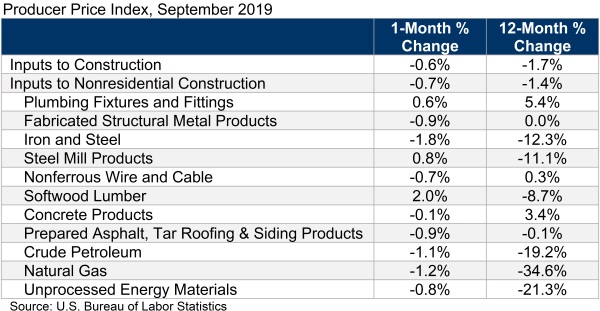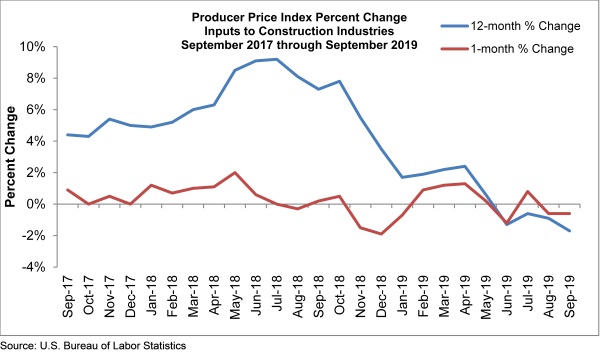
Construction Input Prices Slide in September, Says ABC
Construction input prices fell 0.6% in September and are down 1.7% year-over-year, according to an Associated Builders and Contractors analysis of the U.S. Bureau of Labor Statistics’ Producer Price Index data released today. Nonresidential construction input prices fell 0.7% for the month and are down 1.4% compared to the same time last year.
Much of the year-over-year decline can again be explained by falling energy prices, as crude petroleum (-19.2%), natural gas (-34.6%) and unprocessed energy materials (-21.3%) all plummeted. Only three of 11 key construction-related materials experienced monthly price increases in September: softwood lumber (+2%), steel mill products (+0.8%) and plumbing fixtures and fittings (+0.6%).
“A weakening global economy, a sturdy U.S. dollar and revolutions in technology across much of the energy spectrum continue to contribute to deflationary price pressures in construction materials prices,” said ABC Chief Economist Anirban Basu. “The expectation is that materials prices will continue to remain weak absent a major geopolitical event. Even the drone strike on Saudi Arabia’s oil facilities, which caused oil prices to spike briefly, was insufficient to place meaningful upward pressure on prices.
“Today’s PPI report bodes well for contractors for at least three reasons,” said Basu. “First, contractors continue to wrestle with growing human capital shortfalls, which has helped to bulk up compensation costs, including rising overtime expenditures. All things being equal, rising wage pressures truncate profit margins. Stable materials prices help to countervail that to an extent. Second, the lack of apparent inflationary pressures makes it more likely that interest rates will remain low. Anything that keeps the cost of capital low for developers and other project owners is generally positive for construction spending.
“Third, there is growing concern that the overall cost increase associated with the delivery of construction services has resulted in a growing number of projects being delayed or cancelled,” said Basu. “Much of this has to do with the lack of skilled workers, which has subcontractors scrambling for capacity. Today’s release, which shows that many materials prices are decreasing, helps to abate the pace at which construction service delivery costs are rising. That will help extend the current construction spending cycle.”







